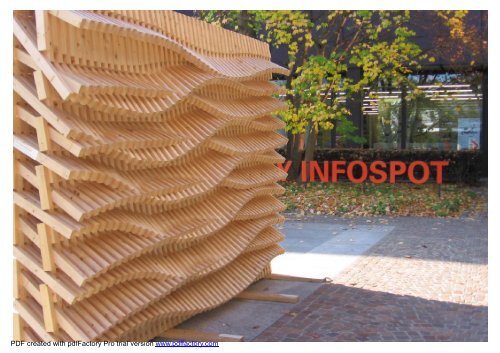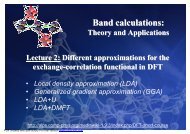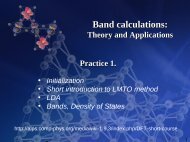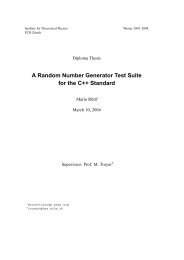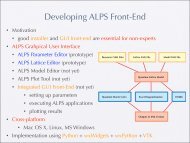Lecture 1 - ALPS
Lecture 1 - ALPS
Lecture 1 - ALPS
Create successful ePaper yourself
Turn your PDF publications into a flip-book with our unique Google optimized e-Paper software.
LiteratureMost useful:1. R.G. Parr and W. Yang “Density-functional theory of atomsand molecules”, New York (1989)2. R. Martin “Electronic structure: basic theory and practicalmethods”, Cambridge (2004)3. M. Springborn “Methods of electronic-structure calculations: frommolecules to solids” (2000)Others:1. A. Szabo and N. Ostlund “Modern quantum chemistry”New York (1997)2. W. Kohn “Nobel <strong>Lecture</strong>: Electronic structure of matter -wave functions and density functional”Rev. Mod. Phys. 71, 1253 - 1266 (1999)PDF created with pdfFactory Pro trial version www.pdffactory.com3
First method to calculate electronic ofstructure of complex systems: Hartree (1928)One-particleapproximation:We want to get a description of the system with hamiltonian:Since we want to find properties of the ground statewe will use variational principle:PDF created with pdfFactory Pro trial version www.pdffactory.com6
First method to calculate electronic ofstructure of complex systems: Hartree (1928)We obtained single particle Schrodinger equation from the variational principle.The way how to solve it was proposed by Douglas Hartree ...PDF created with pdfFactory Pro trial version www.pdffactory.com7
First method to calculate electronicstructure: Hartree equations (1928)DouglasHartree1897-1958Hartree equations:Analogue of Weiss theory in magnetismElectron in the mean-field V HCoulomb interaction withthe mean-field createdall others electronsCharge-densityCoulomb interactionwith ionsThey need to be solved for every i and rIn practice different, matrix formulationof Hartree equations is usedPDF created with pdfFactory Pro trial version www.pdffactory.com8
Matrix form of Hartree equations:(Roothaan 1951)Let's chose the basis set: c kmdoes NOT depend on r !In this case variation proceduremust be done only with respect to c km:Taking all variationsexplicitly one gets:Advantages: (1) matrix elements may be calculated just ONCE ! (2) a set ofintegro-differential equation is reduced to non-linear matrix equation:SCF:or for orthonormalbasis set :c mpH mpImportant: H pm is defined by c mp , but H pm also defines c mpPDF created with pdfFactory Pro trial version www.pdffactory.commp!9
Slater determinant-mth electron occupies kth spin-orbital{ n,l,}k = m l, m sHartree product:Not antisymmetric with respect to the particle permutation !Slaterdeterminant:Antisymmetric with respect to the particle interchange !PDF created with pdfFactory Pro trial version www.pdffactory.com10
Hartree-FockmethodVladimirFock1898-1974Slaterdeterminant:The Hartree-Fock method is the method where the orthonormalwavefunctions, forming (single) Slater determinant,are found to minimize total energy of the system.δE = δ ΨHFH ΨHF= ...All the math is the same as in Hartree-Fock theory (see textbook of Springborn) ...Hartree-Fockequations:PDF created with pdfFactory Pro trial version www.pdffactory.com11
Hartree-FockmethodVladimirFock1898-1974Exchange partOccupations accordingto Hund's ruleNot a functionalof the density !Non-localpotentialBut this is not really a big dealsince matrix formulation it's justTotal energy:PDF created with pdfFactory Pro trial version www.pdffactory.com12
Hartree-Focktheory:Physical meaning of orbital energiesUp to nowwere just Lagrange multipliers:whereLet's find energy of removing rth electron:Koopmans' theorem: energies of filled(empty) orbitals in HF theory equal tochange in the total energy, if electronsubtracted from (added to) the system,keeping all other orbital the same.I.e. we neglect relaxation process!PDF created with pdfFactory Pro trial version www.pdffactory.comCrystal field splitting (in meV) in t 2gsub-shellcalculated within DFT (not HF!) fromorbital energies and taking into relaxationsPRB 71,245114 (2005)13
Application of Hartree-FockmethodBinding energy of H 2D.G. Pettifor “Bonding and structure of molecules and solids”A. Szabo and N. Ostlund “Modern quantum chemistry”PDF created with pdfFactory Pro trial version www.pdffactory.com14
Exchange and correlationsin band theory: definitions1. Exchange interaction in band theory*:Exchange = Hartree - (Hartree-Fock)* do NOT mix with exchange in Heisenberg model !2. Correlations:Correlation = (Hartree-Fock) -(true many-electron interaction)PDF created with pdfFactory Pro trial version www.pdffactory.com15
Exchange and correlationsin band theory: definitions1. Exchange interaction in band theory*:Exchange = Hartree - (Hartree-Fock)* do NOT mix with exchange in Heisenberg model !2. Correlations:Correlation = (Hartree-Fock) -(true many-electron interaction)Important: there is NO “selfinteraction” in HF due to equalfooting consideration of directCoulomb and Exchange terms:This not the case in DFT !PDF created with pdfFactory Pro trial version www.pdffactory.com16
EnricoFermi1901-1954Thomas - Fermi –Dirac modelPaul AdrienDirac1902-1984Let's consider1) non-interacting electronic gascharge-density:Kinetic energy:Exchange energy:2) For real, interacting systems, we take density-density form of Coulomb repulsionThen total energy E is a “function” of n(r) ) only !PDF created with pdfFactory Pro trial version www.pdffactory.com17
Density functional theory (DFT):or «everything is defined by density»Let's think that real compound differs from non-interactingThomas-Fermi-Dirac gas due to some local external potential V(r)Thomas-Fermi-Dirac:T[n], U[n], K[n]The basic theorem of DFT (Hohenberg and Kohn, 1964). The ground-statedensity n(r) of a bound system of interacting electrons in some external potentialv(r) determines this potential uniquely (i.e. up to uninteresting additive constant).Let's n(r) -density of thenondegenerate ground-state;Reductivo ab absurdum:v 1(r) – potential for which corresponding ground-state wavefunctionis , total energy E 1and density n(r)PDF created with pdfFactory Pro trial version www.pdffactory.com18
DFT: Hohenberg-Kohn theorem (1964)Let there is another potential v 2(r) so that it corresponds to ground-statewavefunction, energy E 2and the same density n(r)Since is the wavefunction ofnondegenerate ground stateSimilarly,2Adding last equations leads to contradiction:Hence there is no second potential v 2(r) not equalto v 1(r)+const,, which results in the same density.The requirement of nondegeneracy can easily be lifted see, Parr –Yang textbookPDF created with pdfFactory Pro trial version www.pdffactory.com19
DFT: Hohenberg-Kohn variational principleHartree-Fock theoryLetis the class of trial wave functions which give charge-density, whereHohenberg-Kohn variational principle:where“The formidable problem of finding the minimum ofwith respect to the 3N-dimensional trialfunctions has been transformed into theseemingly trivial problem of finding the minimum ofwith respect to the 3D trial function ”W. Kohn Rev. Mod. Phys. 71, 1253 (1999)PDF created with pdfFactory Pro trial version www.pdffactory.com20
DFT: Hohenberg-Kohn variational principleThe definition of leads us back to minimization with respect to 3Ndimensionaltrial . Nevertheless significant formal progress has been made:the strict formulation of the problem in terms of the ground-state densities.Important 1:potential v(r).is universal function, it doesn't depend on externalImportant 2: Once we know an explicit form foraccurate), we can apply this method for any system.Unfortunately, explicit form ofis unknown(approximate orSo DFT is very nice, mathematically rigorous, but practically useless theory,which gave a job for hundreds (if not thousands) scientists looking for F[n(r)]since 1964 up to nowadaysPDF created with pdfFactory Pro trial version www.pdffactory.com21
DFT: Kohn-Sham trick (1965)The problem is actually in the explicit form of T[n] for interacting system:Hohenberg-Kohnvariational principle:Hohenberg-Kohntheorem:kinetic energyE=min n(V[n]+F[n])?where F[n] = T[n] + U[n]Ext. potential (latticeor whatever)e-e repulsion atleast in densitydensityformKohn-Shamansatz: Let's consider the non-interacting reference system, with(trick)the same density n(r) ) as for interacting one.Then we need to findminimum ofE=min n(V[n]+E xc[n]+F[n])where F[n] = T s[n] + J nn[n]Can be takenfrom TFDtheoryPDF created with pdfFactory Pro trial version www.pdffactory.com22
DFT: Kohn-Sham equation (1965)The only problem to be solved now is howone should chose E xc [n] ] ?<strong>Lecture</strong> 2The one particle Schrodinger equation can be in a similar way as wedid in Hartree-Fock approach:Taking into account thatPDF created with pdfFactory Pro trial version www.pdffactory.com23
DFT: Kohn-Sham equations (1965)Kohn-Shamequationsby definition:For the crystal withoutany external fields:PDF created with pdfFactory Pro trial version www.pdffactory.com24
DFT: Important remarksKohn-Sham wave-functions and energieshave NO explicit physical meaning, except two fact:1.a)must give true observable1.b) Value of the highest occupied , relative to the vacuum is exactlythe ionization energy for bulk materials [Phys. Rev. B 31, 3231 (1985)]This is a strong contrast with Hartree-Fock theory, but eventhere Koopmanns theorem should be taken into account.Ionization energy of Hydrogen atom:E exact (H) = 1.0 Rye LDA (H) = 0.538 Ry
DFT: working and not workingexamplesGaAsGeSolid line: LDA calculated E(k)[PR 129, 138 (1963)]Dots: ARPES data [PRL 43, 82 (1972)]PDF created with pdfFactory Pro trial version www.pdffactory.comSolid line: GW calculated E(k) [PRB 48, 17791(1993)]Dots: PES and IPES data [PRB 32, 2326 (1985),PRB 47, 2130 (1993)]Dashed: LDA calculated [PRB 31, 879 (1985)]26


